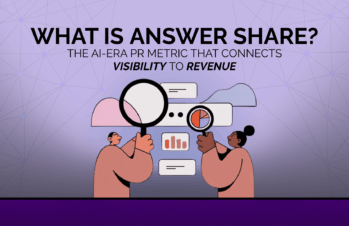They say opposites attract to create an exciting relationship, and a B2B brand’s SEO and PR teams could take notes.
Public relations (PR) and search engine optimization (SEO) don’t always—or even often—appear to work closely together. While PR strategies most often deal with deep external research, media relations, press releases, earned media coverage, thought leadership placement, and the public perception of your brand reputation, SEO works behind the scenes. As part of digital marketing, SEO is primarily concerned with internal work, optimizing your brand’s website, handling paid ads, tracking and adding high-quality backlinks, search engine rankings, and so on.
But if and when businesses decide to execute an SEO PR strategy, the benefits can be huge. That’s because your brand’s online reputation and search engine optimization work together to support PR campaigns that not only ensure your messages reach relevant audiences but also drive organic traffic to your site. Here are 10 easy ways SEO can be implemented to amplify your PR efforts.
Related post: How to Create a Winning B2B SEO Campaign in 2025
Note that these tips are designed to help you amplify your PR hits, not specifically to earn more press coverage. Think of this list as a way to ensure that you’re employing SEO best practices whenever and wherever possible since the PR coverage you earn is, by its nature, not something you have complete control over.
- Optimize links in earned coverage
- Manage media outreach
- Write solid title tags and meta descriptions for every post
- Amplify content across all channels
- Build trust with brand consistency
- Prioritize video in your strategy
- Consider newsjacking
- Build creative campaigns
- Leverage the power of influencer marketing
- Consistently publish content
1. Optimize links in earned coverage

Earned media coverage is what every business’s end goal is. Not only is it cheaper in the long run, but it is a huge asset to SEO, and as we all know, a big part of SEO is optimizing.
Your SEO team should be helping your PR team to optimize links for any earned media coverage. This includes things like non-paid stories, press releases, magazine features, and more.
The SEO team is there to help choose the best keywords for each piece of content. Keywords should be selected based on which ones need a ranking boost. Your SEO experts can then make sure that the PR professionals pull the right URL to link to keywords.
However, the partnership doesn’t stop here. SEO can also consult PR to ensure all search engine rules are followed. PR professionals may be unfamiliar with search engine penalties, so it’s SEO’s job to make sure any and all links are up to par with the search engine. For example, SEO can check if any links from paid sponsorships are “nofollows” and if the same keyword is not linked throughout one piece of content. By doing this, not only does PR gain knowledge on how to utilize keywords and links, but search engine penalties are avoided.
2. Manage media outreach

Outreach is at the heart of any B2B SEO strategy and should be done correctly and consistently. When it comes to outreach, you can run the risk of both the SEO and PR team contacting the same site or publisher. It can be confusing for the publisher and site owners, so it’s important to properly coordinate outreach between both teams.
Establish these roles during strategy planning, not after, so there is no confusion during the execution phase. For example, the SEO team can handle reaching out to bloggers for their link-building campaign (those high-quality backlinks mentioned earlier), while PR focuses on contacting publications and the media.
This creates a higher success rate for both teams as they clearly know where to focus their attention. To take it a step further, PR and SEO can collaborate and optimize their respective content before sending it off to publishers and bloggers—talk about teamwork! This ensures that the content in the pipeline is at the highest quality level, thus providing a higher chance of success and positive media coverage.
3. Write solid title tags and meta descriptions for every post

One of the key benefits of B2B PR is getting increased organic traffic to your website. This is the result of optimization and makes it essential that PR and SEO are on the same page. Even the PR team’s best content achieves nothing if it lacks proper optimization to reach your target audience.
This is where the importance of title tags and meta descriptions comes in. The SEO team has a list of keywords relevant to your brand and content that they can utilize to gain more clicks and views. To improve the likelihood that your audience sees the content, add these keywords to the web page’s content. Include a title tag that defines the document and a meta description that provides a summary as part of search result snippets.
Each page should ideally have its own unique tags and descriptions that come together in the end and help search engines understand what the page is about and where to index it accordingly. Generally, the SEO team will know how to implement these meta elements and what rules to follow, such as title tags being fewer than 70 characters and meta descriptions being 150 to 160 characters long. By doing so, your SEO strategy will garner the results PR anticipates.
4. Amplify content across all marketing channels

When it comes to content, specifically amplifying it, PR and SEO can prove to have a very beneficial relationship. SEO has the ability to boost public relations efforts by sharing any existing or upcoming content through PR media contacts.
Creating content is a big task that takes time and involves conducting research, appealing to your target audience, and applying creative interactive assets. After all that hard work, you want your content to be seen. That’s where PR comes in.
By involving PR in promoting your content, you will definitely get the most out of your work. PR has media contacts in credible publications and can push out your engaging and informative content. Not only is it a great way to build links for SEO, but it also attracts new visitors, gains media coverage, and establishes your credibility and trustworthiness within our industry.
Related reading: The Four Types of Media: Rented, Owned, Paid, Earned
5. Build trust with brand consistency

Digital PR professionals spend a lot of time crafting messaging that influences a consumer’s perception of your company. It’s important to remember that all messaging should be consistent across every social channel and platform. No one will know what you’re trying to tell them!
PR best practices in SEO, in this case, is to ensure brand consistency by relaying key messages to the right social platform and people at the right time. For example, in a more technical sense, if you see a brand at an event, then notice its features in a publication, and come across them in the SERPs, it means you are seeing similar positioning and messaging over and over.
This not only helps build brand awareness but reinforces brand consistency. The public relations team focuses on brand messaging, while the SEO team ensures customers see brand messages online and balance the available information.
6. Prioritize video in your strategy

Video marketing is a great way to work with Google’s internal algorithm. When you publish a piece of content, Google doesn’t only look at the text but also any other types of media you might have to offer. Google sees this as you having informative, authoritative content giving you that extra SEO boost.
Users like to watch videos for more clarification on a product or business. They are even more likely to visit your website by watching a video on YouTube or another social channel. Videos are also the reason users might stay on your site for longer. Google sees the amount of traffic you’re generating and makes it easier for users to find your content.
If you aren’t already doing it, then begin filming those videos! Shoppers are twice as likely to purchase from your site if they view a product video or content that emphasizes the product via visuals. This helps increase your SEO by getting more traffic on your site and persuades them to convert. In the end, videos are an essential factor of any SEO strategy, and it is definitely something you want to take advantage of.
7. Consider newsjacking

Newsjacking is one of the most effective tactics for generating PR content. It may sound complicated, but it only consists of sharing your thoughts and perspective on breaking news. It’s the practice of leveraging top headlines to support your brand’s goals.
To newsjack effectively, your team should monitor media in real-time to find trending topics. You can also newsjack with current events and find relevant ones on which your brand can share insight.
This way, when something happens in the news, PR and SEO can work together to create optimized content that shows your brand has a reason to care. You can leverage the topic’s popularity by providing your thoughts and feelings and inserting your brand into the conversation. It’s important to remain reactive and agile in your SEO and PR strategy and remember that you have a greater chance at success by jumping on real-time news, as it can become irrelevant the next day.
8. Build creative campaigns

We know that campaigns are one of the best ways to use SEO to amplify your PR efforts, but creative campaigns are where audiences come flocking. Creative campaigns can resonate with audiences far beyond your target market and bring about a new wave of brand awareness.
For example, popular creative campaigns with established brands as thought leaders include Dove’s “Real Beauty” campaign and the #LikeAGirl campaign from Always. Both of these campaigns encouraged young women to feel empowered by being themselves. The latter gained more than 67 million views and 4.4 billion impressions in the first three months.
Campaigns like these become buzzworthy and highly influence media coverage, impressions, views, backlinks, and social media activity. Your SEO team should ensure all brand mentions are optimized to support your brand’s SEO efforts.
Related reading: Build a Successful B2B PR Strategy
9. Leverage the power of influencer marketing

B2B influencer marketing is bigger than ever. Brands worldwide have taken to influencer marketing as a way to generate PR opportunities and raise brand awareness. One of the best ways to get results with influencer marketing campaigns is to use SEO to magnify any landed media coverage.
This is done by first picking the social media channels you would like to target and a list of influencers that fit with your brand. You can also engage with said influencers on social media by tweeting them, DMing them, or sending them a piece of content you would like them to share. It’s important to be unique in your delivery since influencers’ mentions are likely full of hundreds of articles, stories, and the like.
Another way to leverage the power of influencers is by engaging with content published by said influencers. You can use it as a starting point for a much larger discussion and gain their attention by responding directly to something they said. Whatever method you choose, B2B influencer marketing represents a powerful force and should play an important role in your SEO and PR strategy.
Related reading: The Ultimate Guide to Social Media Platforms for B2B Influencer Marketing
10. Consistently publish your own content

Finally, consistently publishing your own valuable content, blogs, webinars, slideshares, interviews, etc., is something your SEO and content teams should be working on regularly.
By coordinating your PR outreach with the SEO team’s keyword strategy and the content team’s content strategy, you’ll be able to better amplify any press hits you get while providing plenty of new content for potential clients to find online.
The SEO and PR teams aren’t often seen as partners—but they should be. They’re both crucial for maintaining and improving brand reputation. Implementing PR best practices within your SEO tactics will give you more mileage out of each press hit while continuously improving your website’s ranking for target keywords.Retry
SEO PR Strategy: A Valuable Asset for a Positive Brand Image and Online Reputation
The secret to amplifying PR efforts with SEO performance comes down to both SEO and public relations teams having a mutual understanding of what the other does. By communicating and working together, SEO and PR teams have the power to move your brand forward and push past your competitors.If you need help getting your PR and SEO efforts off the ground, let’s talk!




